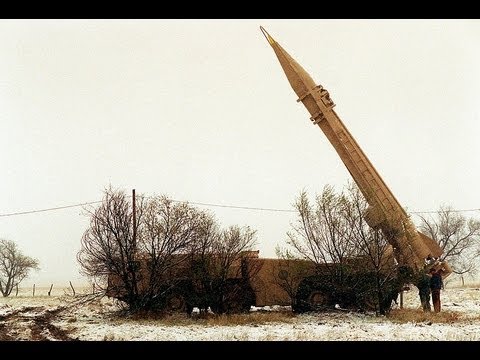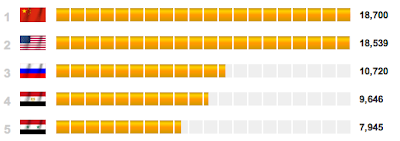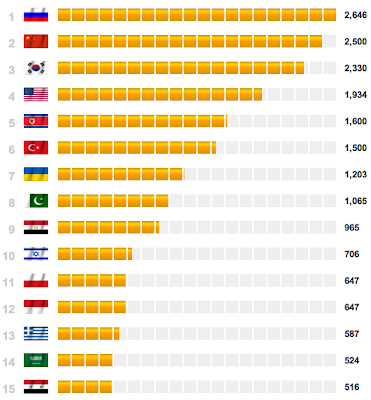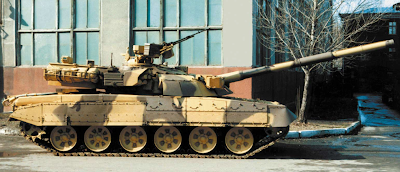
With Syria's future now in the sights of the world's superpower, I wanted to take a brief look at what the world is up against. Syria, despite its overall small population and economy, actually has a very substantial military.
According to Global Firepower, Syria's land-based military systems are substantial. The Syrian Army is equipped as follows:
1.) 4150 tanks putting them in sixth place overall as shown on this graph:
2.) 7945 armoured fighting vehicles which includes Armoured Personnel Carriers and Infantry Fighting Vehicles, both tracked and wheeled, putting them in fifth place as shown on this graph:
3.) 516 self-propelled guns putting them in 15th place overall as shown on this graph:
4.) 1336 Multiple Launch Rocket Systems putting them in fifth place overall as shown on this graph:
GlobalSecurity provides slightly different data. They state that Syria has about 4850 tanks in total, most of which are of the T-55 variety, an upgraded version of an older, proven Soviet tank. The T54 and T55 have been produced in greater numbers than any other tank in the world and have been in continuous production since 1945. This tank is most effective against light to medium armoured vehicles. The Syrian Army also uses a new version, the T-55 MV, first introduced in 1983. This tank has a 100 mm main gun and a maximum aimed range of 2500 metres. Its ammunition can penetrate 200 millimetres of armour at a range of 1000 metres. Syria's Army also has about 1600 T-72 and T-72M tanks, another Soviet tank that was first introduced to the public in 1977. It is equipped with a 125 mm main gun and is capable of penetrating the Abrams M1 tank armour at a range of up to 1000 metres. It has a maximum aimed range of 2000 metres and can penetrate up to 630 mm of armour at a range of 2000 metres. Here is a photo of a T-72:
Of greater interest is Syria's air defense capabilities. The nation has a total of over 6000 anti-aircraft systems, including over 4000 SA-7 Grails, a portable, shoulder-fired, low-altitude surface to air missile system with infrared homing capabilities. It has a maximum range of 5500 metres and can reach an altitude of 4500 metres.
Syria has one of the largest missile arsenals in the Middle East, largely acquiring missiles to deter Israel. Syria also has 38 Scud B/C and D surface-to-surface missile (SSM) launchers. Here is a photo of a mobile Scud launcher:
It is estimated that Syria has over 500 Scud missiles. The Scud family of missiles are, once again, Soviet-sourced and have been upgraded continuously since they were first introduced in the mid-1950s. The Scud B, introduced in 1957, has a range of 300 kilometres and can be equipped with a nuclear, conventional or chemical warhead weighing up to 1000 kilograms. The Scud C was introduced in 1965, has a range of between 575 and 600 kilometres and can be equipped with chemical warheads including VX weighing up to 770 kilograms. The Syrian Army is currently upgrading the Scud D with assistance from North Korea, an enhanced missile version of which was first acquired from that nation in 2001. Syria's modifications will increase the missile's range and make it more difficult to intercept by allowing the 700 kilogram warhead to separate from the main body. Syria is now modifying their older Scud C missiles into Scud D versions at a reported 50 missiles per year. This missile has a range of up to 700 kilometres and can be equipped with nuclear, conventional or chemical warheads.
This is what a Syrian Scud launch and attack looks like:
Syria also produces a variant of Iran's Fateh 110A missile, a road-mobile short-range ballistic missile. In this missile, the fuel can be stored in the missile as it is being moved, making it difficult to detect a planned launch since the long process of fuelling is not necessary. Syria also may possess two models of Chinese road-mobile short-range ballistic missiles, the Dongfeng 15 and the Dongfeng 11 with ranges of up to 800 kilometres. In addition, Syria has a number of Russian anti-ship cruise missiles that are designed for coastal defense. These missiles can also be equipped with chemical warheads.
With all of this data in mind, it will be interesting to see what happens in the coming weeks and months and whether President Obama is forced to put "boots on the ground" to end the conflict in Syria. As we found out in Iraq and Afghanistan, the battles that look relatively easy to win on paper, aren't necessarily victories over the long
Click HERE to read more of Glen Asher's columns
You can publish this article on your website as long as you provide a link back to this page.







Be the first to comment